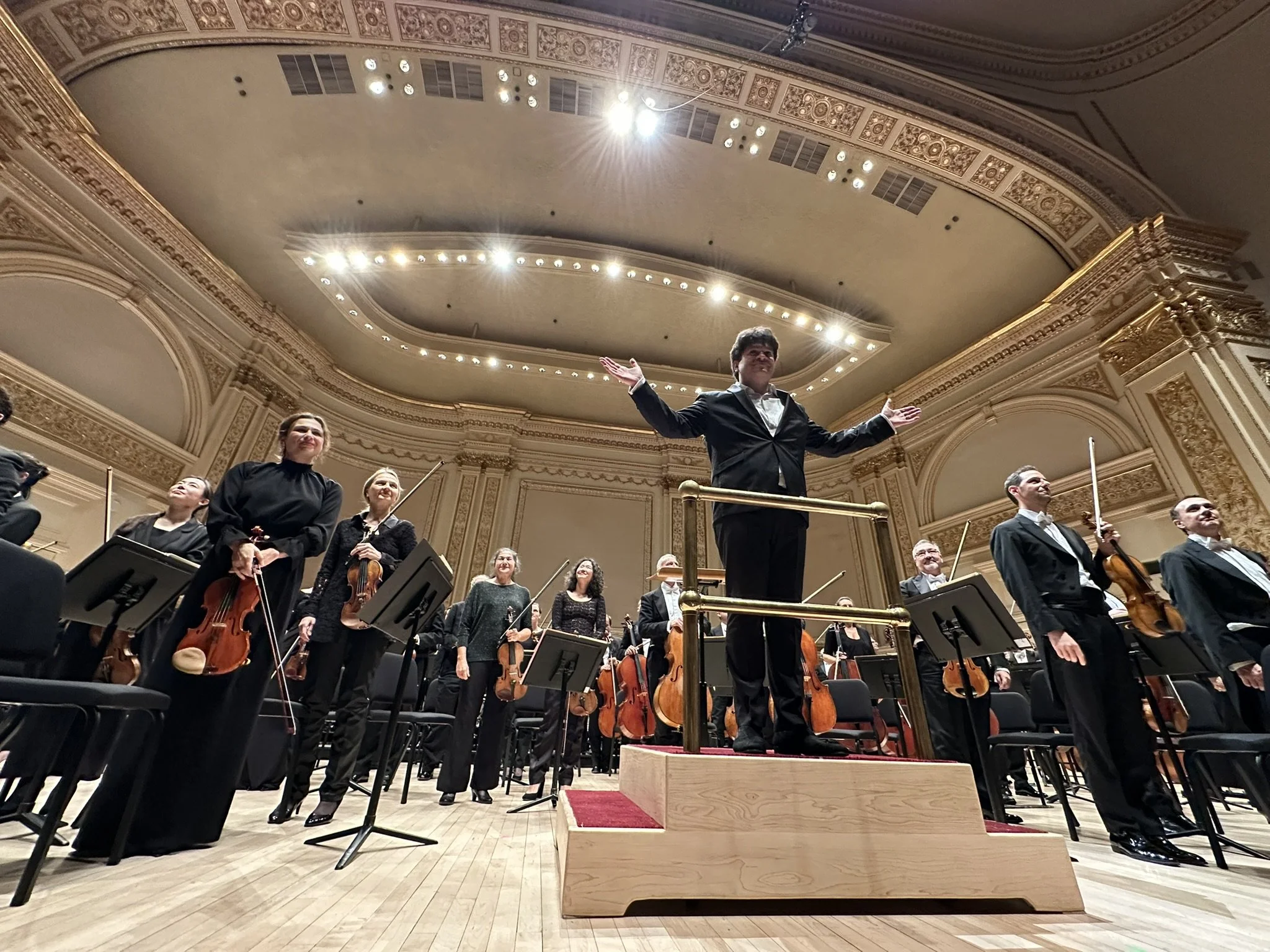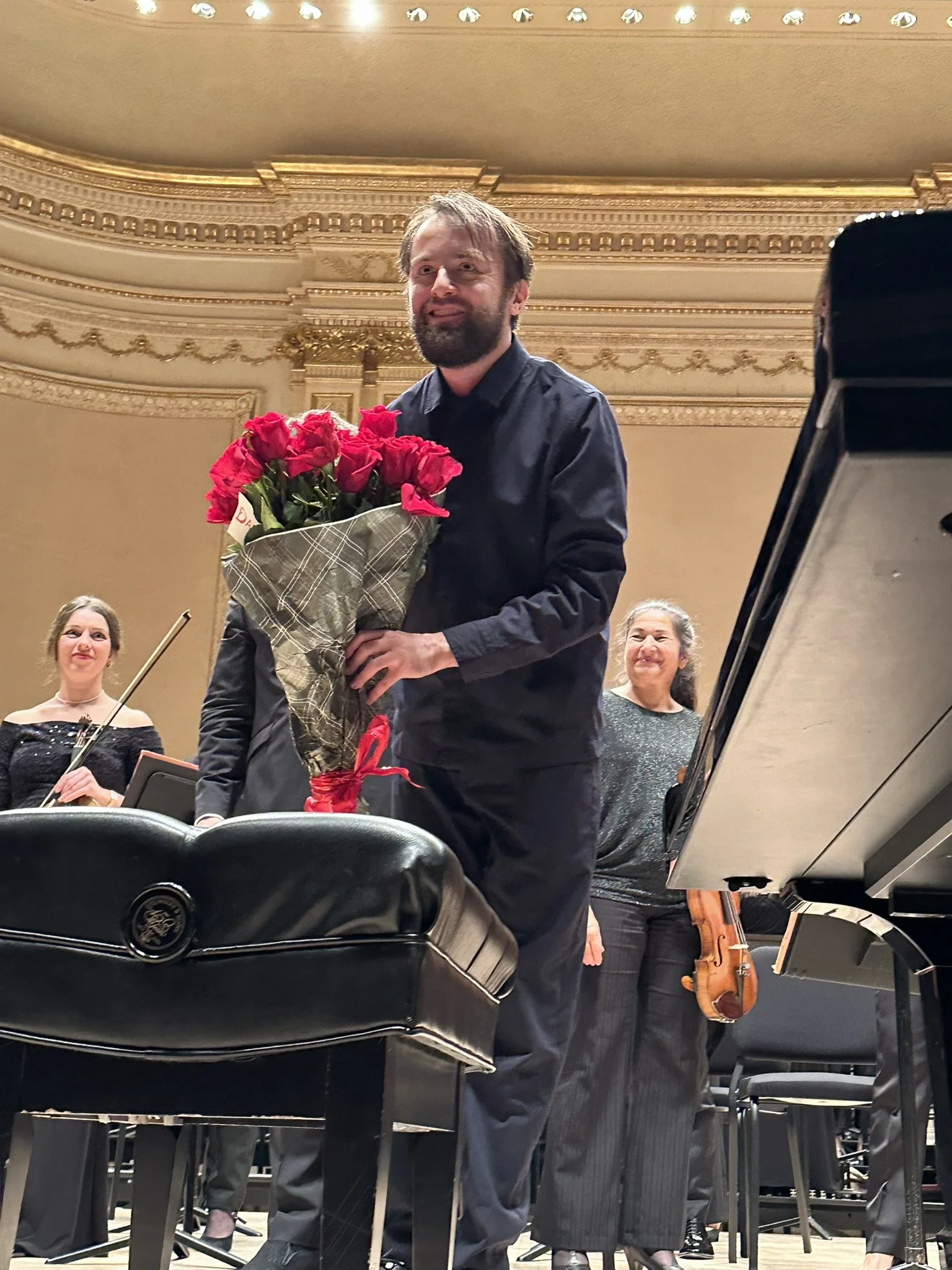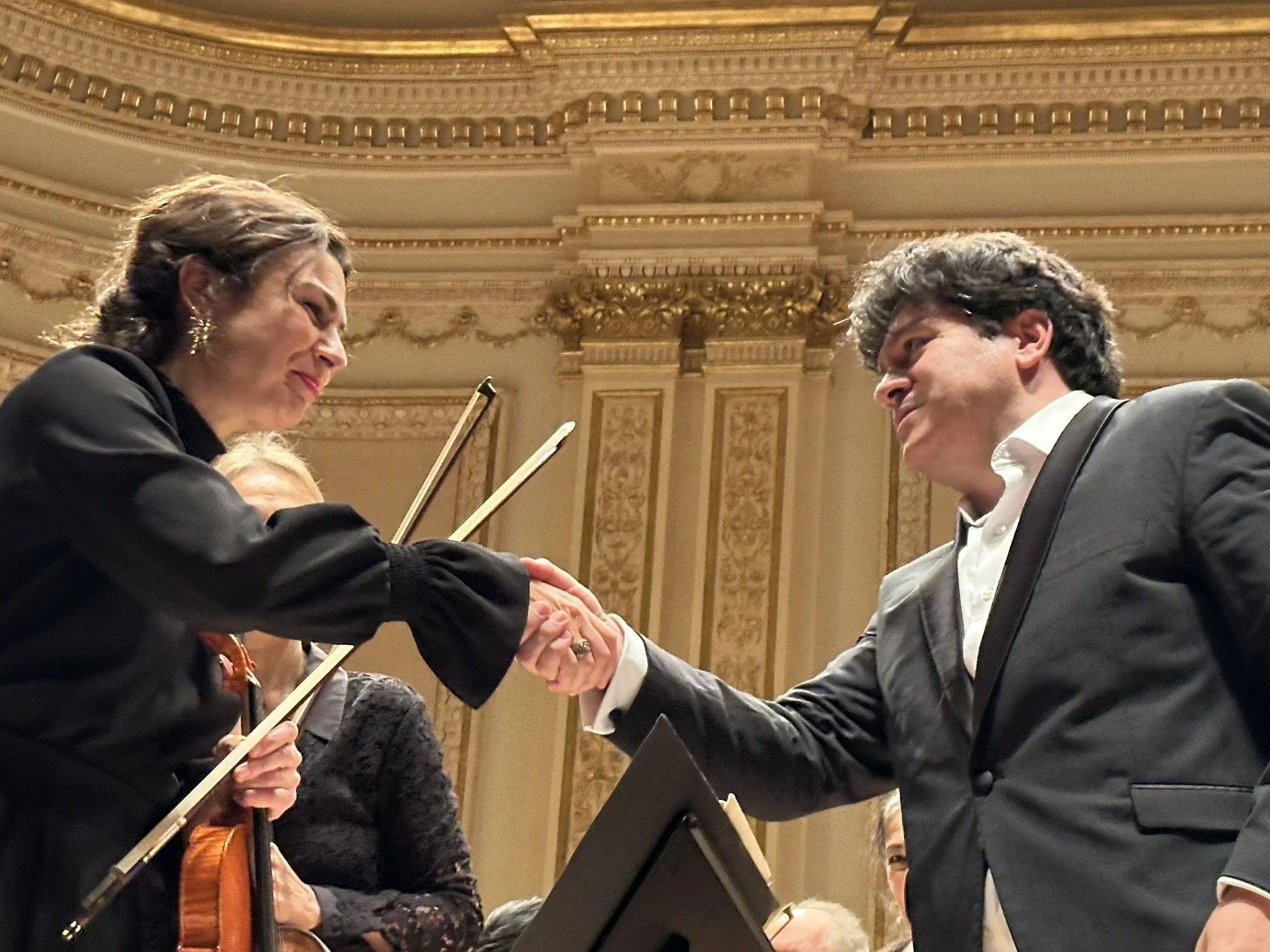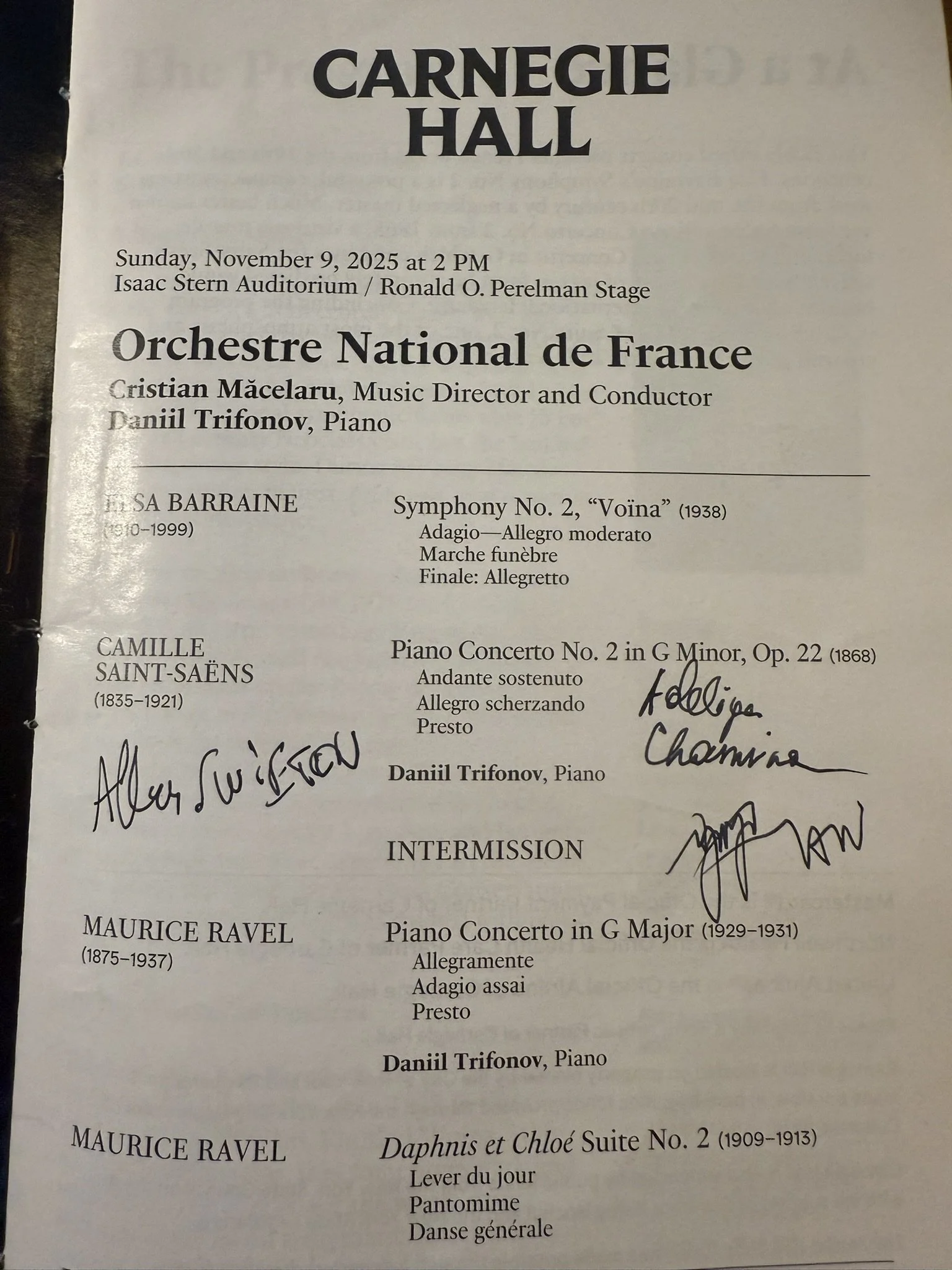Christian Măcelaru and the Orchestre National de France at Carnegie Hall on 11.9.2025. The program began with Elsa Barraine’s Symphony No. 2, Voïna (War), composed in 1938, just before the outbreak of World War II. Barraine’s work captivates with its modern French transparency condensed into a stable structure.
In the Allegro first movement, the rhythmic themes evoke Shostakovich and Prokofiev. The tempo slows in the midsection before accelerating into intense tremolos, creating a repeated dialogue in which the collective power of the ensemble intersects with individual suffering. The rapid dotted rhythms toward the end recall Strauss’s Don Juan. The coda intensifies the rhythmic drive yet stops with a mideum crescendo, leaving a lingering resonance.
The second movement, Marche funèbre, is a funeral march that seems to be drawn into a single darkness. Hushed human presences approach subtly. The cymbals shine sharply. Bassoons and lower strings mark time slowly with transparent mid-lows, while wind and violin solos unfold, eventually sinking back into the darkness. Shadows of crowds and memories lie within the rhythms, harmonies, and timbres, evoking silence and recollection and reflecting psychological depth in sound.
The third movement blends the march theme in 5/8 (2+3 and 3+2) with celesta, scattering sparks of light within the darkness to create a glittering effect of memory, adding delicate brilliance amid chaos. The theme never returns to the tonic, preserving a springy vitality while giving a sense of stasis.
The sound was polished to perfection, with an ensemble that dissolved light into sound. Sonorité was felt constantly. Strings were transparent with resonant mid-lows, woodwinds added soft shading reminiscent of Honegger and Dutilleux, and brass exhibited brilliance and restraint. In Carnegie Hall’s acoustics, the middle voices were particularly prominent. Barraine’s contrapuntal writing brings the movement of the spirit to the mid-range, reflecting psychological depth in the music.
Concertmaster Sarah Nemtanu was remarkable. Within Barraine’s unique world, she responded to Măcelaru’s sincere conducting. She seemed to prioritize something beyond herself. Her presence was gorgeous yet fully supportive, elevating everything around her. Every gesture, every motion, every nuance of the music seemed to be an integral part of her entire being, making her an essential part of the orchestra. The orchestra, under her leadership and with a precision akin to that of the Bavarian Radio Symphony Orchestra, maintained sectional cohesion based on a unique musical vision, achieving ensemble perfection that surpassed that of the Paris while balancing discipline and playfulness.
The second piece, Ravel’s Piano Concerto (1931), arranges Gershwin-like approachable themes with transparent French color and clear harmonies. Every element was exquisitely refined, revealing Ravel’s fascination with the playfulness of jazz. For the first time, I experienced Trifonov’s perspective up close. He does not perform to showcase technique. With razor-sharp focus on the work, he adapts to the size of the hall and the audience’s attention, presenting the solo passages with precise interpretation while blending seamlessly with the orchestra in tutti and unison passages. It was as if he were serving a tennis ball at maximum speed, landing it within a centimeter of the target—utterly precise.
Măcelaru followed Trifonov’s solo and flow, using a palette of orchestral colors that combined playfulness and variety. Trifonov’s brilliance lies not in virtuosity but in his attitude and commitment to clearly conveying the work’s charm. His concentration reminds the listener of the value of attentive, sustained listening; every detail is precise and lucid. While some maestros might transport one into a haze, music guided by Trifonov’s focus leaves a lasting memory. He does not engage in the stage performance; even after the performance, his modesty ensures the music’s impression remains undisturbed. He prioritizes the connection between the audience and the work above all. The concerto may sound improvised, yet it is meticulously calculated, with musical patterns resembling modern art. He controls the density of sound like a Formula 1 driver, adjusting both quantity and quality to make the melodies stand out. Arpeggios gain depth and shading, enhancing the work’s transparency and dreamlike qualities. Trifonov’s performance clarifies Ravel’s ambiguity and fantasy, creating a transparent dialogue with the orchestra whose flow and textural changes are delightful.
The third piece, Saint-Saëns’ Piano Concerto No. 2 (1868), featured an orchestral opening cadenza that evoked Brahms and Bach. The piano solo themes were lyrical and Chopinesque, while contrapuntal structures and contrasts of light and dark recalled Bach and Brahms. The second movement suggested Berlioz’s coloristic development, and the third movement unfolded with the brilliance and power of Beethoven’s Fifth Piano Concerto. Trifonov and the orchestra render the dialogue vivid and distinct. The encore, DEBUSSY "Reflets dans l'eau" from Images I (Daniil Trifonov)
Ravel’s Daphnis et Chloé, born from the conflict with Diaghilev, this large-scale orchestral work opens with shimmering arpeggios that rise naturally from the misty bass, interwoven with the brilliance of harp and other instruments. Măcelaru and the Orchestre National de France brought out mid-range themes, particularly in the violas, emerging like the breath of the earth from within the orchestra. The impression was one of musical sonorité rather than dynamic force. Into these themes flowed a variety of colors and timbres. This experience was the opposite of the sense of being drawn into darkness in Barraine’s second movement. Soft woodwind shading recalled Honegger and Dutilleux, and the orchestra carefully shaped form, color, and space to convey narrative and psychological scenes vividly. In pantomime-like passages, the transparent mid-range, woodwinds, and strings gradually revealed psychological motion, with the orchestra illuminating the stage as light, interweaving solos, subtle timing, and emotional fluctuation. Măcelaru and the orchestra maintained meticulous attention to color and direction, letting the interweaving solos emerge vividly from layers of sound and timbre. Each voice was carefully visualized, with shape, color, and spatiality rendered. Fine details and nuances naturally spun the drama. While the third movement recalls Stravinsky, it favors ethereal fantasy and the interplay of natural light over wildness or ritual, and the distinctly French character persisted until the final crescendo.
It was the best of the season since September 2025. While other concerts offered excitement and emotional intensity, the combination of program and execution here was unparalleled. Every instrument in the orchestra performed excellently. While one may feel moved when imperfections are corrected or balances improved in other concerts, these musicians calmly enjoyed their style, and their sessions with the pianist and conductor were compelling in a way that set them apart. It was evident that the orchestra’s hearts were unified at every moment.
For me, the image of France is the Orchestre de Paris with its luxurious sound and brilliant solos designed to delight the audience. Yet the Orchestre National de France, in the Boléro encore, fused individual personalities with collective consciousness, revealing every detail of the work. I had long thought of Boléro as a long-sustained dynamic; in reality, when the whole violin section played the theme in the latter half, they sang it rhythmically. Boléro came alive and breathed.
Performers
Orchestre National de France
Cristian Mǎcelaru, Music Director and Conductor
Daniil Trifonov, Piano
BARRAINE Symphony No. 2
RAVEL Piano Concerto in G Major
SAINT-SAËNS Piano Concerto No. 2
RAVEL Daphnis et Chloé Suite No. 2
Encores:
DEBUSSY "Reflets dans l'eau" from Images I (Daniil Trifonov)
RAVEL Boléro
クリスティアン・マチェラルとフランス国立管弦楽団が11月9日の日曜午後にカーネギーホールで演奏会を行った。プログラムは1938年、第二次世界大戦前に作曲されたエルザ・バレーヌの交響曲第2番、Voïna(戦争)から始まった。近代フランス音楽の透明な響きが安定した構造に凝縮されているバレーヌ作品の魅力。1楽章のアレグロでは、刻みのテーマがリズムで進んでいく様子はショスタコーヴィチを、またプロコフィエフを思わせた。中間部でテンポが落ち、加速し激しいトレモロに入り、集団の力と個の苦悩が交差するような対話を繰り返す。終わりの付点の早い動きは、シュトラウスの、ドン・ファンのようだ。コーダで刻みが強くなり、最後はクレッシェンドせずに停止し、鳴らし切らない余韻を残す。2楽章、Marche funèbre、葬送行進曲。1つの闇に流れが吸い込まれていく。ヒソヒソと人の気配が迫ってくる。シンバルが鋭く光る。ファゴットや低弦が透明な中低音でゆっくり時を刻み、管楽器やバイオリンのソロが展開され、やがて再び闇に吸い込まれる。リズムやハーモニー、音色に群衆の影や記憶が潜み、沈黙と記憶の空気を描き出し心理の陰影を音で映し出す。3楽章は2+3と3+2の5拍子で行進曲のテーマにチェレスタがブレンドされ、、音の闇に光がちりばめられ記憶のきらめきのような効果を生み、混沌の中に繊細な輝きを添えていた。テーマは主音に帰らず、ばねのある躍動を保ちつつ、どこにも進めない感覚を与える。
本当によく磨かれた音色とアンサンブルで光を溶かしていくような響き。常にソノリテを感じる。弦は透明で中低音は張りがあり、木管はオネゲルやデュティユーの柔らかな陰影を添え、金管は輝きと節度があった。カーネギー・ホールの響きの中では特に中声部が際立つ。バレーヌの対位法は中音域に精神の動きを浮かび上がらせ、心理の深みを音楽に反映している。
コンサートマスターのSarah Nemtanuがすごかった。バレーヌ独特の世界の中でマセロウの誠実な指揮に答えていく。彼女は自分より優先することがある人だった。存在感は豪華なのに、全てを引き立て盛り上げる。そのドラマ、動き、所作、全ての音楽が全身にインストールされオーケストラの一部になっていた。そして、オーケストラはバイエルン放送管ように高い精度で独自の音楽観でセクションが統率され、パリ管よりもアンサンブルの完成度が高く、堅実と遊びを両立していた。
2曲目、ラベルのピアノ協奏曲(1931)は、ガーシュインの親しみやすい曲調をフランスの透明な色彩と明快な和声でアレンジしてある。どのパーツも最高に洗練されている。ラベルがジャズの面白さを発見し魅了されたことよくわかる。私は初めてトリフォノフの目の前で、彼の視点を体験した。彼は技巧を披露する人ではない。研ぎ澄まされた作品への集中で、会場の大きさや聴き手の注意に合わせて、ソロでは適格なアプローチで作品を細部まで魅せ、オーケストラとの掛け合いやユニゾンでは音色を完全に溶け込ませる。それはテニスのサービスを最高スピードで反対側のコーナーに1cm刻みで着地させていくように卓越している。指揮のマセロウも、トリフォノフのソロや流れに合わせ、トゥッティに、多彩で自由な遊びと統合されたな音色を使い分ける。トリフォノフのすごいところは、技巧よりも、作品の面白さを鮮明に伝える気持ちと態度だ。その集中力から聴き手は通してじっくりと聴くことの尊さを改めて教えられる。なぜなら、細部まで誠に鮮明で適格。普通のマエストロの演奏はタイムスリップしてしまうが、彼の集中と態度によって導かれた音楽は記憶に残る。彼はステージパフォーマンスをしない。演奏が終わっても、控えめなために、音楽の印象が掻き消されない。グネーシンの教えだ。あくまで聴衆と作品の繋がりを何よりも大切にされている。この曲は即興に聴こえるが計算されている。全ての音型が現代アートのようだった。音の密度のコントロールがF1のようだ。音の量と質を調整して旋律を浮き立たせる。和音のアルペジオに奥行きを与え、陰影をつけることで、曲の透度や幻想性を際立たせる。トリフォノフの演奏はラベルの曖昧さや幻想性を明晰に展開し、オーケストラとの透明な対話が生まれ、その流れとテクスチャの変化を深く楽しめる。
3曲目、サンサーンスのピアノ協奏曲2番(1868)では、冒頭のカデンツからブラームスやバッハを思わせる力強いオーケストラ。ピアノソロの主題はショパンのようにしっとりしているが、対位する構造や、明暗や緩急の対比がバッハやブラームスを思わせる。2楽章はベルリオーズの色彩と展開を思わせ、3楽章はベートーベン5番のピアノ協奏曲の華やかで力強い展開。それぞれ、トリフォノフもオケも明晰で適格な表現で対話がより鮮明だった。アンコールは夜のガスパール。
1番驚いたのが、ラベルのダフニスとクロエ。ディアギレフとの対立の中でうまれた大編成のオーケストラ曲。冒頭の湧き上がるような分散和音から、バスの霧の中に自然と立ち上がる響き、そしてハープやさまざまな楽器が交わす輝き。クリスティアン・マチェラルとフランス国立管弦楽団のビオラを中心とした中音域のテーマが、大地の息吹のようにオーケストラの内側から現れる。ダイナミクスの勢いより、ソノリテの音楽の存在が印象に残る。そして、そのテーマに多彩な音色が飛び込んでくる。この体験は、バレーヌの2楽章の闇に吸い込まれていく感覚と真逆。管楽器の柔らかな陰影はオネゲルやデュティユーを思わせ、音のの形、色、空間を丁寧に展開させ、物語の情景や心理を鮮やかに浮かび上がらせていく。パントマイムでは、中音域や木管、弦の透明な響きで、その心理や動きが徐々に立ち上がり、オーケストラ全体が舞台を照らす光となり、多彩なソロが織り交ざり、微妙な間と心理の揺らぎが浮かび上がる。マチェラルとオーケストラは、ここでもソノリテの色と方向に細心の注意を払い、多彩に織り交ざるソロを湧き上がるように音の層や色彩の中で鮮やに繰り広げる。声部を丁寧に可視化し、音の形や色、空間を表現する。音の細部や微妙なニュアンスで自然にドラマを紡ぎ出していく。3楽章はストラビンスキーとよく似ているが、野生や儀式より、透明な幻想性と自然の光の交わりが最後まで続き、クレッシェンドしきって終わるまでフランスの香りがした。
2025年の9月からの公演で一番うまい演奏だった。面白さや、感情の盛り上がりは他の公演でも楽しめたが、プログラムの内容と演奏の完成度では今シーズンで一番うまかった。オーケストラの楽器はみんなうまかった。何かが欠けていたり、バランスが悪かったり、ダメだったのがよくなったりして感動もするが、この人たちは冷静に彼らのスタイルを楽しんでいるし、ピアニストや指揮者とのセッションも、説得力が違った。見ていると、オケの人たちの心がどの場面でもひとつだった。私の思っているフランスはパリ管だ。豪華な響きと卓越したソロの数々を披露して楽しませてくる。
しかし、フランス国立管弦楽団は、アンコールのボレロは、個性と全体の一部としてのメンバーの建設的な意識が融合し、作品の細部が鮮明だった。これまでボレロの印象を長く続くダイナミクスと考えていたが、実際には、後半でバイオリン全体がテーマを演奏すると、彼らはボレロをリズミカルに歌っていた。ボレロが生き生きと呼吸していた。





